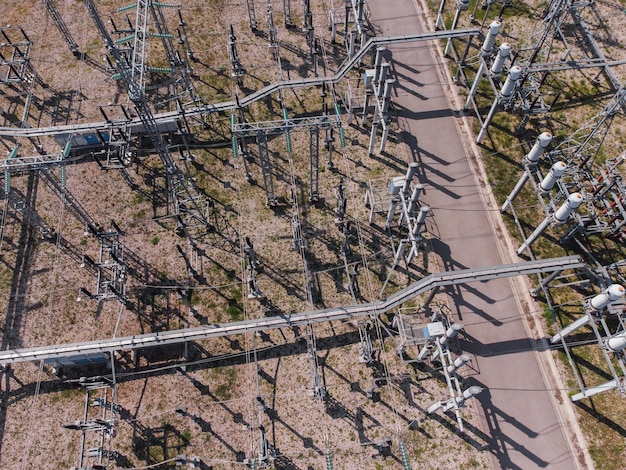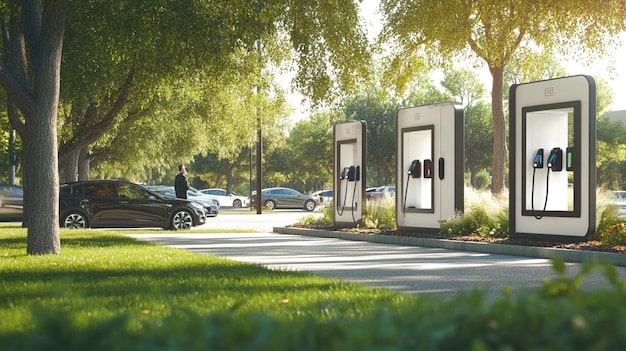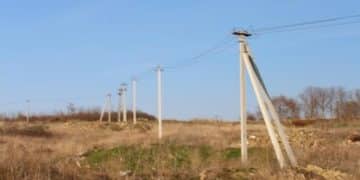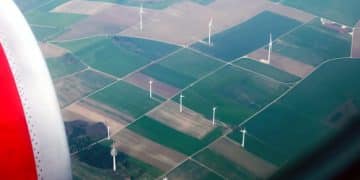Bipartisan Infrastructure Law: Key Clean Energy Provisions in 2025

The Bipartisan Infrastructure Law includes several key provisions aimed at supporting clean energy deployment in 2025, such as funding for grid modernization, renewable energy projects, and electric vehicle infrastructure, all designed to accelerate the transition to a cleaner energy future.
Navigating the landscape of clean energy policy, it’s essential to understand what are the key provisions of the Bipartisan Infrastructure Law supporting clean energy deployment in 2025. This legislation is poised to significantly impact the future of energy in the US, and this article dives deep into its core components.
Understanding the Bipartisan Infrastructure Law’s Clean Energy Focus
The Bipartisan Infrastructure Law, enacted in 2021, represents a historic investment in America’s infrastructure. A significant portion of this investment is dedicated to accelerating the deployment of clean energy technologies. Understanding the key provisions related to clean energy is crucial for stakeholders across the energy sector.
Modernizing the Electric Grid
One of the central goals of the law is to modernize the nation’s electric grid, enabling it to handle increased renewable energy generation and improve overall reliability.
Investing in Renewable Energy Projects
The law allocates substantial funding to support the development and deployment of various renewable energy projects, including solar, wind, and hydropower.
- Grid Resilience: Enhancing the grid’s ability to withstand extreme weather events.
- Transmission Infrastructure: Building new transmission lines to connect renewable energy sources to population centers.
- Energy Storage: Supporting the development of energy storage technologies to improve grid stability.

These investments are designed to create a more resilient and efficient grid, capable of supporting a cleaner energy future. By addressing key infrastructure challenges, the law aims to unlock the full potential of renewable energy resources.
Funding for Renewable Energy Technologies
The Bipartisan Infrastructure Law dedicates significant funding to various renewable energy technologies, each playing a critical role in reducing carbon emissions and diversifying the energy mix.
Solar Energy Initiatives
Funding is directed towards initiatives that promote the deployment of solar energy technologies, from residential rooftop systems to large-scale solar farms.
Wind Energy Development
The law supports the development of both onshore and offshore wind energy projects, recognizing the vast potential of wind power as a clean energy source.
- Tax Incentives: Providing tax credits and other incentives to encourage investment in renewable energy projects.
- Research and Development: Supporting research and development efforts to improve the efficiency and reduce the cost of renewable energy technologies.
- Loan Programs: Offering loans and other financial support to help renewable energy projects get off the ground.
The funding for these technologies underscores the law’s commitment to driving innovation and accelerating the adoption of renewable energy across the country. These investments are poised to create new jobs, stimulate economic growth, and reduce the nation’s reliance on fossil fuels.
Expanding Electric Vehicle Infrastructure
Recognizing the growing importance of electric vehicles (EVs) in reducing transportation emissions, the Bipartisan Infrastructure Law includes provisions to significantly expand the nation’s EV charging infrastructure.
National Electric Vehicle Infrastructure (NEVI) Formula Program
The NEVI Formula Program provides funding to states to deploy EV charging stations along designated alternative fuel corridors.
Discretionary Grant Programs
The law also establishes discretionary grant programs to support EV charging infrastructure projects in communities across the country.

- Charging Station Deployment: Building a network of fast-charging stations to support long-distance EV travel.
- Community Charging: Installing charging stations in underserved communities to promote equitable access to EVs.
- Workplace Charging: Encouraging employers to install charging stations for their employees.
By addressing the lack of charging infrastructure, the law aims to encourage more consumers to switch to EVs, reducing greenhouse gas emissions from the transportation sector. This investment will not only support the growth of the EV market but also create new opportunities for businesses and workers in the charging infrastructure industry.
Promoting Energy Efficiency Upgrades
Energy efficiency plays a crucial role in reducing energy consumption and lowering carbon emissions. The Bipartisan Infrastructure Law includes provisions to promote energy efficiency upgrades in buildings and industrial facilities.
Weatherization Assistance Program
The Weatherization Assistance Program receives increased funding to help low-income households improve the energy efficiency of their homes.
Building Energy Codes
The law supports the development and implementation of updated building energy codes to promote energy-efficient construction.
- Retrofit Programs: Offering incentives for homeowners and businesses to upgrade their buildings with energy-efficient technologies.
- Industrial Efficiency: Providing technical assistance and financial support to help industrial facilities improve their energy performance.
- Appliance Standards: Strengthening appliance efficiency standards to reduce energy consumption from household appliances.
These investments in energy efficiency will not only reduce energy costs for consumers and businesses but also lower overall energy demand, making it easier to transition to a cleaner energy system. By targeting both residential and industrial sectors, the law aims to achieve significant energy savings across the economy.
Investing in Carbon Capture and Storage
Carbon capture and storage (CCS) technologies are viewed as a potentially important tool for mitigating climate change. The Bipartisan Infrastructure Law includes provisions to support the development and deployment of CCS projects.
Carbon Capture Demonstration Projects
The law provides funding for demonstration projects to test and scale up carbon capture technologies at industrial facilities.
CO2 Transport and Storage Infrastructure
The law supports the development of infrastructure to transport and store captured CO2 safely and permanently.
- Direct Air Capture: Investing in direct air capture technologies that remove CO2 directly from the atmosphere.
- Geological Storage: Identifying and developing suitable geological formations for long-term CO2 storage.
- Industrial Decarbonization: Helping industrial facilities reduce their carbon emissions through CCS and other technologies.
While CCS remains a controversial technology, these investments reflect the law’s commitment to exploring all potential solutions for reducing carbon emissions and combating climate change. The success of these projects could play a significant role in helping the nation achieve its climate goals.
Supporting Clean Hydrogen Production
Clean hydrogen is emerging as a promising energy carrier with the potential to decarbonize various sectors of the economy. The Bipartisan Infrastructure Law includes provisions to support the production, transportation, and use of clean hydrogen.
Regional Clean Hydrogen Hubs
The law establishes a program to create regional clean hydrogen hubs across the country, bringing together hydrogen producers, consumers, and infrastructure providers.
Hydrogen Production Technologies
The law supports research, development, and demonstration of various hydrogen production technologies, including electrolysis and natural gas reforming with carbon capture.
- Fuel Cell Technologies: Promoting the use of hydrogen fuel cells in transportation, power generation, and industrial applications.
- Hydrogen Storage and Transportation: Developing infrastructure for storing and transporting hydrogen safely and efficiently.
- Industrial Feedstock: Using hydrogen as a clean feedstock in industrial processes.
By supporting the development of a clean hydrogen economy, the law aims to create new jobs, stimulate economic growth, and reduce carbon emissions across multiple sectors. The success of these initiatives could pave the way for a more sustainable energy future.
| Key Area | Brief Description |
|---|---|
| ⚡ Grid Modernization | Upgrading power grids for reliability and renewable energy integration. |
| 🚗 EV Infrastructure | Expanding electric vehicle charging networks across the US. |
| 🌱 Renewable Energy | Funding for solar, wind, and other clean energy projects. |
| 🏭 Carbon Capture | Supporting carbon capture and storage technologies for industrial decarbonization. |
Frequently Asked Questions
▼
The Bipartisan Infrastructure Law is a comprehensive piece of legislation enacted in 2021 that allocates significant funding towards improving infrastructure across the United States, including transportation, energy, and broadband internet.
▼
The law supports clean energy deployment through various provisions, such as funding for grid modernization, renewable energy projects, electric vehicle infrastructure, and energy efficiency upgrades. These initiatives aim to accelerate the transition to a cleaner energy future.
▼
The National Electric Vehicle Infrastructure (NEVI) Formula Program provides funding to states to deploy electric vehicle charging stations along designated alternative fuel corridors, helping to establish a comprehensive charging network across the country.
▼
Regional clean hydrogen hubs are programs established by the law to bring together hydrogen producers, consumers, and infrastructure providers in specific regions of the country, fostering collaboration and accelerating the development of a clean hydrogen economy.
▼
The law promotes energy efficiency through increased funding for the Weatherization Assistance Program, supporting the development of updated building energy codes, and offering incentives for energy-efficient upgrades in buildings and industrial facilities.
Conclusion
In conclusion, the Bipartisan Infrastructure Law is a transformative piece of legislation that provides substantial support for clean energy deployment in 2025 and beyond. By investing in key areas such as grid modernization, renewable energy technologies, electric vehicle infrastructure, and energy efficiency, the law aims to accelerate the transition to a cleaner, more sustainable energy future for the United States.





